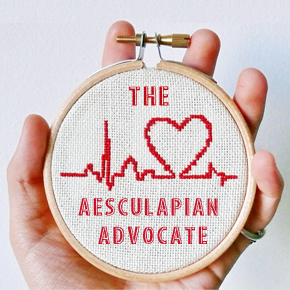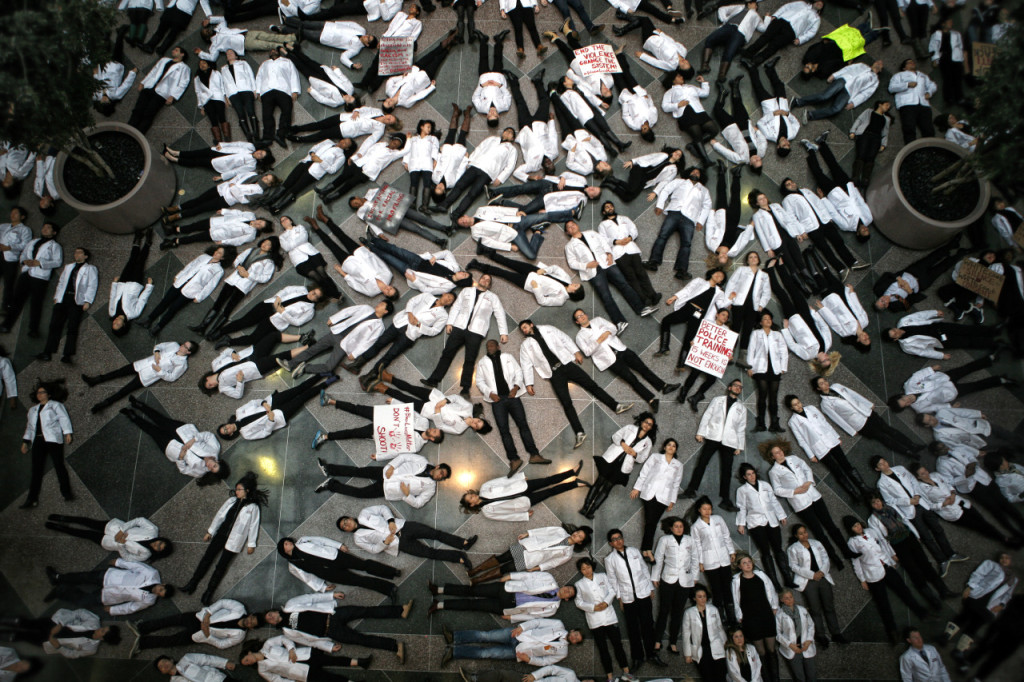Today is International Human Rights Day and the one-year anniversary of last year’s national White Coat Die-In to support the #BlackLivesMatter movement. The coordinated die-in protests drew national attention highlighting racism as a public health issue. To cite the original #ActionsSpeakLouder callout: “Across the nation today, silent protests at medical schools in New York, Philadelphia, Houston and San Francisco call on medical schools and academic medical centers to move beyond mission statements and slogans in their efforts to promote racial justice. Specifically, students will be making two demands of their schools:
- Enroll an incoming medical school class that that is representative of the American people: at least 13 percent black students, 1 percent Native American students and 17 percent Latino students.
- Ensure that members of medical schools’ local communities, particularly people of color, have full access to care at academic medical centers without financial hardship.
Students will be highlighting disparities between the stated values of their medical schools and their actual actions using the hashtag #ActionsSpeakLouder.”

Students at medical schools nationwide demand their schools enroll Black, Latino, and Native American students and ensure access to health care for patients in their local communities.
Medical students across the country will be active on campus and on social media, coordinated by the national medical student organization White Coats for Black Lives, with the support of Students for a National Health Program (SNaHP), American Medical Student Association (AMSA), Student National Medical Association (SNMA), the Latino Medical Student Association (LMSA) and the Committee for Interns and Residents (CIR).
This is a crucial issue because as the callout notice states: “Racism is one of the major health problems in the United States: excess mortality claims 83,000 black lives each year, making racism a more potent killer than prostate, breast or colon cancer. Addressing racism and its consequences must therefore be a central goal of American medical schools as they carry out their two key functions: educating future physicians and caring for patients.”
To provide an example, black people represent roughly 13 percent of our nation’s population, but only 4 percent of the physician workforce. Physicians of color are more likely to provide care for America’s underserved communities and patients of color report higher satisfaction when their doctor shares their racial background. Increasing the numbers of black, Latino and Native American doctors is a therefore key step in eliminating health inequities.
Moreover, many of our medical centers contribute directly to health inequality by excluding patients of color from their hospitals. Although it is illegal for hospitals and practices to discriminate against patients based on race, it is legal and indeed common practice to deny care to patients on the basis of their insurance status.
For example, at many academic medical centers, patients with Medicaid insurance cannot make appointments in faculty practices; instead, they are seen in trainee and student-run clinics. Given that black, Latino and Native American patients are much less likely to have private insurance than their white counterparts, such a system effectively ensures that they do not have access to the cutting edge care that academic medical centers pride themselves on providing.
At a recent Harvard Medical School Leadership Forum, Dr. Camara Phyllis Jones, MD, MPH, PhD who is the President of the American Public Health Association, addressed the topic “Achieving Health Equity: Tools for National Conversation on Racism.” As a social epidemiologist, her work on “race”‐associated differences in health outcomes goes beyond documenting those differences to vigorously investigating the structural causes of the differences.
Echoing the sobering facts above, Dr. Daniele Olveczky, a gerontologist of Beth Israel Deaconess Medical Center, stood up at this forum to share her story. “I’m a provider of color. Every day I face racism from my patients. I face racism from my coworkers. I love my job and I love what I do every single day, but at the end of the day [facing racism] is so tiring.”
While her candor may seem disheartening to some, Dr. Eddy Chen, an oncologist at the Dana Farber Cancer Institute, voiced his support saying that, “as an Asian-American man, professor, and cancer doctor, I hear you, I’m with you, and I am an ally.”
Today, let us all be allies for our patients, for our communities, and for those whose voices who are so often unheard. #ActionsSpeakLouder.
#ActionsSpeakLouder protests held at medical schools across the country, including but not limited to:
Baylor College of Medicine
Case Western Reserve University School of Medicine
Columbia University College of Physicians and Surgeons
Geisel School of Medicine at Dartmouth
Howard University College of Medicine
Icahn School of Medicine at Mount Sinai
Lewis Katz School of Medicine at Temple University
The Ohio State University College of Medicine
Penn State Hershey College of Medicine
Perelman School of Medicine at the University of Pennsylvania
Rowan University School of Osteopathic Medicine
Sidney Kimmel Medical College at Thomas Jefferson University
Touro University California, College of Osteopathic Medicine
University of California Berkeley/University of California San Francisco Joint Medical Program
University of California Davis School of Medicine
University of California Los Angeles School of Medicine
University of California San Diego School of Medicine
University of California San Francisco School of Medicine
I encourage you to read more about WC4BL at the official website.
A column reflecting on the privileges and responsibilities we have as physicians-in-training to advocate for those who do not have the power to do so themselves. Devoted to issues of social justice and health equity, this column hopes to spark conversations and inspire action within each reader’s community at large.


